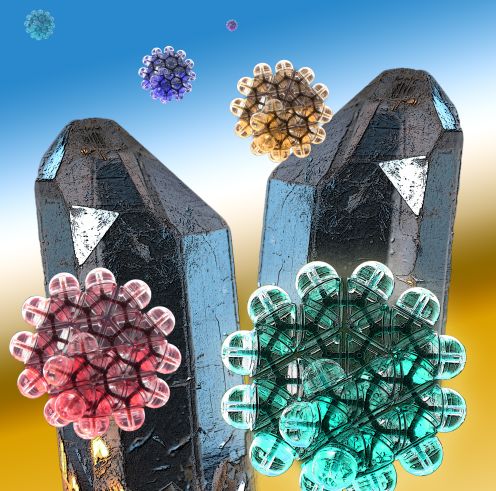Empa researchers investigate crystals at the molecular level – new study published in “Nature“ 1)
Crystals in the mirror
Some crystals such as quartz are found naturally in two mirror-image forms. Empa scientists have been able to “observe” molecules during crystal growth using the scanning tunnel microscope, and have thereby discovered why, under particular conditions, only one form of crystal grows. A report on this work will be published next week in the renowned scientific journal “Nature”.

|
Legend: Mirror images from nature: two mirror-image quartz crystals “orbited” by models of helicene molecules. Helicene consists of seven linked hydrocarbon rings which form a short “spiral staircase” structure. |
||||
|
What is true for some crystals is also often true for their constituent molecules: certain substances exist in two forms which bear the same geometric relationship to each other as do our left and right hands. With biomolecules, those building blocks of life, this “handedness” is known scientifically as chirality, and it is a common phenomenon. For example amino acids, from which proteins are made, exist for all practical purposes in one form only, and the same is true for sugar molecules. Many substances used for medicinal purposes also occur in two mirror-image forms. The seemingly small difference in the two forms can have a significant effect – the compound ethambutol is, for example, effective against tuberculosis in one form, but in its other it causes blindness. In such cases the pharmaceutical industry spares no effort to separate the two forms, but this is often a complicated and expensive process as only a few properties of the two forms differ from one another significantly. One means of obtaining mirror-image molecules in pure form is crystallization; under certain conditions only one of the two forms is deposited in the growing crystal. This effect was discovered by the French “all-round researcher” Louis Pasteur, who was able in 1848 to separate the left and right hand crystals of a tartaric acid derivative under the microscope with tweezers. How and why molecules separate during crystallization and why they create mirror-image crystals remains a mystery even today. Crystals in two dimensions Since it is hardly practicable to observe crystal growth in solution at the molecular level, Empa researchers from Karl-Heinz Ernst’s laboratory investigated “two-dimensional” crystals grown on a smooth surface. These can develop spontaneously in a vacuum, for example on a copper surface. The scientists evaporated the chiral compound helicene above a copper surface in a small reaction chamber. Helicene molecules consisting of seven stacked hydrocarbon rings and have the shape of a short right or left handed spiral staircase, hence the two mirror image forms. The trick mastered by the Empa researchers was to provide only just enough helicene to create a single layer of molecules packed in a tight and orderly manner on the copper surface. Ernst and his colleagues then used the ultra fine tip of a scanning tunnel microscope to trace over the surface of the monomolecular helicene layer to determine the orientation of the individual molecules in the crystal lattice. When the researchers measured pure left-handed helicene, they found the crystal structure to be – as expected – the mirror image of that of the pure right-handed substance. The chirality of the helicene molecules had therefore been transferred to the two crystal forms, as Ernst and his team reported in the journal “Angewandte Chemie“ two years ago. |
||||
|
The crystalline form can be determined in advance But which form of crystal is created when a mixture of left and right handed helicene molecules is used? The researchers investigate this question in the study which appears in the current issue of “Nature”. The answer is that a kind of mixed crystal develops on the copper surface, with some areas showing one form of handedness and other areas showing the mirror image form. The Empa team therefore assumed that the two helicene forms had separated, with the left handed molecules forming one form of crystal and the right handed ones the other. “We even published this theory” says Ernst. But the researchers were mistaken, as the close-up measurements with the scanning tunnel microscope showed. “Both crystal forms showed a rather unusual arrangement of constituent molecules, a sort of zigzag structure which was significantly different from the crystal structure of the pure chiral helicene molecule.” Further investigation revealed that the crystal building block was in fact not a single helicene molecule but a molecular pair, a “dimer” consisting of one left handed and one right handed helicene molecule. Since the two molecules can “snuggle-up” to each other in two different ways, two different mirror image crystal forms exist. |
|||
|
What would happen, mused Ernst, if there was more of one form of helicene – say the left handed variety – than the other? If the mixture consists of 54 percent left handed helicene and 46 percent of the right handed form (or vice versa) then only one crystal type forms over the whole surface. The excess helicene molecules which find no partner are deposited at the edges of the crystal and force it to take on a definite structure. “Since these two dimensional crystal structures can act as seeds for “real”, that is three-dimensional, crystals we are hopeful that we can use this principle to simplify methods to separate pharmaceuticals by crystallization” says Ernst confidently. |
||||
|
1) Nature, 26. Januar 2006, Vol. 439 Author: Dr. Michael Hagmann, Communication, +41 44 823 45 92, Contact: Dr.
Karl-Heinz Ernst, Molecular Surface Science, +41 44 823 43 63,
|
||||
|
|||
|
|||

